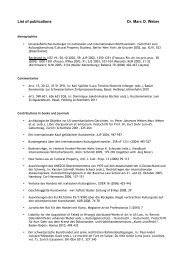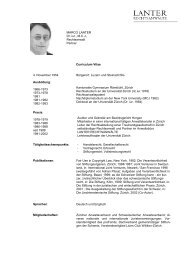Liability for the Acquisition of Faked or Wrongly Attributed Works of ...
Liability for the Acquisition of Faked or Wrongly Attributed Works of ...
Liability for the Acquisition of Faked or Wrongly Attributed Works of ...
You also want an ePaper? Increase the reach of your titles
YUMPU automatically turns print PDFs into web optimized ePapers that Google loves.
III. Warranty<br />
1. Express warranty<br />
Although art buyers claim various warranties under U.C.C. § 2, <strong>the</strong> predominant<br />
challenge is that <strong>the</strong> art is inau<strong>the</strong>ntic, 5 a claim <strong>of</strong>ten framed as a breach <strong>of</strong> express<br />
warranty 6 under U.C.C. § 2-313. 7 No court has squarely resolved <strong>the</strong><br />
guess/guarantee conundrum by deciding auth<strong>or</strong>ship classification under U.C.C.<br />
express warranty. 8<br />
a) Greenwood v. Koven<br />
In Greenwood v. Koven 9 , <strong>the</strong> court itself was not called upon to decide whe<strong>the</strong>r<br />
<strong>the</strong> w<strong>or</strong>k was actually by a certain artist, but <strong>the</strong> buyer was admitted to rescind<br />
<strong>the</strong> sale based on <strong>the</strong> terms <strong>of</strong> a consignment agreement. In 1948, defendant and<br />
5 It is <strong>the</strong> buyer-plaintiff who bears <strong>the</strong> burden <strong>of</strong> showing that <strong>the</strong> w<strong>or</strong>k <strong>of</strong> art is not<br />
au<strong>the</strong>ntic; see Dawson v. Malina, 463 F.Supp. 461, 462 (1978): buyer <strong>of</strong> antique chinese<br />
objects sues <strong>the</strong> dealer <strong>f<strong>or</strong></strong> breach <strong>of</strong> express warranty.<br />
6 An interesting regulation on express warranties is provided by § 13.01(1)(b) New Y<strong>or</strong>k<br />
State Consolidated Laws Services Arts and Cultural Affairs Law (Mc Kinney 1984 &<br />
Supp. 2004; reprinted in Patty Gerstenblith, Art, Cultural Heritage, and <strong>the</strong> Law. Cases<br />
and Materials, Durham: Carolina Academic Press 2004, 873), which only applies<br />
between a seller who is an art merchant and a buyer who is not an art merchant, and<br />
acc<strong>or</strong>ding to which a certificate <strong>of</strong> au<strong>the</strong>nticity <strong>or</strong> a similar written instrument shall create<br />
an express warranty.<br />
7 U.C.C. § 2-313 reads, inter alia, as follows: “(1) Express warranties by <strong>the</strong> seller are<br />
created as follows: (a) Any affirmation <strong>of</strong> fact <strong>or</strong> promise made by <strong>the</strong> seller to <strong>the</strong> buyer<br />
which relates to <strong>the</strong> goods and becomes part <strong>of</strong> <strong>the</strong> basis <strong>of</strong> <strong>the</strong> bargain creates an express<br />
warranty that <strong>the</strong> goods shall con<strong>f<strong>or</strong></strong>m to <strong>the</strong> affirmation <strong>or</strong> promise. (b) Any description<br />
<strong>of</strong> <strong>the</strong> goods which is made part <strong>of</strong> <strong>the</strong> basis <strong>of</strong> <strong>the</strong> bargain creates an express warranty<br />
that <strong>the</strong> goods shall con<strong>f<strong>or</strong></strong>m to <strong>the</strong> description (c) […] (2) It is not necessary to <strong>the</strong><br />
creation <strong>of</strong> an express warranty that <strong>the</strong> seller use <strong>f<strong>or</strong></strong>mal w<strong>or</strong>ds such as ‘warrant’ <strong>or</strong><br />
‘guarantee’ <strong>or</strong> that he have a specific intention to make a warranty, but an affirmation<br />
merely <strong>of</strong> <strong>the</strong> value <strong>of</strong> <strong>the</strong> goods <strong>or</strong> a statement purp<strong>or</strong>ting to be merely <strong>the</strong> seller’s<br />
opinion <strong>or</strong> commendation <strong>of</strong> <strong>the</strong> goods does not create a warranty.”<br />
8 Foxley v. So<strong>the</strong>by’s, Inc., 893 F.Supp. 1224 (S.D.N.Y. 1995): challenge <strong>of</strong> au<strong>the</strong>ntication<br />
<strong>of</strong> a painting by Mary Cassatt (1844–1926) which, however, was time-barred by U.C.C.<br />
statute <strong>of</strong> limitations.<br />
9 Greenwood v. Koven, 880 F.Supp. 186 (S.D.N.Y. 1995); reproduced in John Henry Merryman/Albert<br />
E. Elsen/Stephen K. Urice, Law, Ethics and <strong>the</strong> Visual Arts, 5th ed., London/The<br />
Hague/New Y<strong>or</strong>k: Kluwer Law International 2007, 1029–1035, with comments<br />
at 1035–1036; Gerstenblith (supra note 6), 322–328.<br />
412





